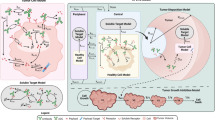Abstract
The paper compares performance of Nonmem estimation methods—first order conditional estimation with interaction (FOCEI), iterative two stage (ITS), Monte Carlo importance sampling (IMP), importance sampling assisted by mode a posteriori (IMPMAP), stochastic approximation expectation–maximization (SAEM), and Markov chain Monte Carlo Bayesian (BAYES), on the simulated examples of a monoclonal antibody with target-mediated drug disposition (TMDD), demonstrates how optimization of the estimation options improves performance, and compares standard errors of Nonmem parameter estimates with those predicted by PFIM 3.2 optimal design software. In the examples of the one- and two-target quasi-steady-state TMDD models with rich sampling, the parameter estimates and standard errors of the new Nonmem 7.2.0 ITS, IMP, IMPMAP, SAEM and BAYES estimation methods were similar to the FOCEI method, although larger deviation from the true parameter values (those used to simulate the data) was observed using the BAYES method for poorly identifiable parameters. Standard errors of the parameter estimates were in general agreement with the PFIM 3.2 predictions. The ITS, IMP, and IMPMAP methods with the convergence tester were the fastest methods, reducing the computation time by about ten times relative to the FOCEI method. Use of lower computational precision requirements for the FOCEI method reduced the estimation time by 3–5 times without compromising the quality of the parameter estimates, and equaled or exceeded the speed of the SAEM and BAYES methods. Use of parallel computations with 4–12 processors running on the same computer improved the speed proportionally to the number of processors with the efficiency (for 12 processor run) in the range of 85–95% for all methods except BAYES, which had parallelization efficiency of about 70%.






Similar content being viewed by others
References
Beal SL, Sheiner LB, Boeckmann AJ, and Bauer RJ (eds) NONMEM 7.2.0 users guides. (1989–2011). Icon Development Solutions, Ellicott City. ftp://nonmem.iconplc.com/Public/nonmem720/guides
SAS User’s Guide, SAS Institute Inc. http://support.sas.com/documentation/cdl/en/statug/63033/HTML/default/viewer.htm#titlepage.htm
Jose Pinheiro, Douglas Bates (2000) Mixed-Effects Models in S and S-PLUS (Statistics and Computing) Springer; 1st ed. 2nd printing edition (April 15, 2009). http://www.springer.com/statistics/statistical+theory+and+methods/book/978-1-4419-0317-4
Jose Pinheiro, Douglas Bates, Saikat DebRoy, Deepayan Sarkar and the R Development Core Team (2011). nlme: Linear and nonlinear mixed effects models. http://cran.r-project.org/web/packages/nlme/index.html
WinNonMix®, Pharsight, Cary, North Carolina
Phoenix® NLME™, Pharsight, Cary, North Carolina. http://www.pharsight.com/products/prod_phoenix_nlme_home.php
PKBUGS project, developed by Dave Lunn, Department of Epidemiology and Public Health of Imperial College at St Mary’s Hospital London. http://www.mrc-bsu.cam.ac.uk/bugs/winbugs/contents.shtml
Lunn DJ, Thomas A, Best N, Spiegelhalter D (2000) WinBUGS—a Bayesian modelling framework: concepts, structure, and extensibility. Stat Comput 10:325–337
Monolix 3.1 user guide, software.monolix.org/download31/Monolix31_UsersGuide.pdf
Kuhn E, Lavielle M (2005) Maximum likelihood estimation in nonlinear mixed effects model. Comput Stat Data Anal 49:1020–1038
Bauer RJ. S-ADAPT/MCPEM User’s Guide, Version 1.57, 2011. http://bmsr.usc.edu/Software/ADAPT/SADAPTsoftware.html
Bauer RJ, Guzy S (2004) Monte Carlo parametric expectation maximization (MCPEM) method for analyzing population pharmacokinetic/pharmacodynamic (PK/PD) data. In: D’Argenio DZ (ed) Advanced methods of pharmacokinetic and pharmacodynamics systems analysis, vol. 3. Kluwer Academic Publishers, Boston, pp 135–163
Bauer RJ, Guzy S, Ng C (2007) A survey of population analysis methods and software for complex pharmacokinetic and pharmacodynamic models with examples. AAPS J 9(1):E60–E83. doi:10.1208/aapsj0901007
Bauer RJ (2011) NONMEM users guide: introduction to NONMEM 7. Icon Development Solutions, Ellicott City
Gibiansky L, Gibiansky E, Kakkar T, Ma P (2008) Approximations of the target-mediated drug disposition model and identifiability of model parameters. J Pharmacokinet Pharmacodyn 35(5):573–591
Mager DE, Jusko WJ (2001) General pharmacokinetic model for drugs exhibiting target-mediated drug disposition. J Pharmacokinet Pharmacodyn 28:507–532
Gibiansky L, Gibiansky E (2010) Target-mediated drug disposition model for drugs that bind to more than one targets. J Pharmacokinet Pharmacodyn 37:323–346. doi:10.1007/s10928-010-9163-3
Gibiansky L, Gibiansky E (2009) Target-mediated drug disposition model: approximations, identifiability of model parameters, and applications to the population pharmacokinetic-pharmacodynamic modeling of biologics. Expert Opin Drug Metab Toxicol 5(7):803–812
Bazzoli C, Retout S, Mentré F (2009) Design evaluation and optimisation in multiple response nonlinear mixed effect models: PFIM 3.0. Comput Methods Programs Biomed 98(1):55–65
NONMEM 7.2 PREDPP source code comments, DVERK1.f90, DGEAR1.f90, LSODI1.f90, LSODA.f90
Press WH, Teukolsky SA, Vettering WT, Flannery BP (1992) Numerical recipes, the art of scientifc programming, 2nd edn. Cambridge University Press, New York, pp 701–744
Nguyen TT, Bazzoli C, Mentré F (2011) Design evaluation and optimisation in crossover pharmacokinetic studies analysed by nonlinear mixed effects models. Stat Med. doi: 10.1002/sim.4390. [Epub ahead of print]
Mentré F, Nyberg J, Ogungbenro K, Leonov S, Aliev A, Duffull S, Bazzoli C, Andrew C. Hooker AC (2011) Comparison of results of the different software for design evaluation in population pharmacokinetics and pharmacodynamics. PAGE 20 Abstract 2066 [www.page-meeting.org/?abstract=2066]
Author information
Authors and Affiliations
Corresponding author
Electronic supplementary material
Below is the link to the electronic supplementary material.
Rights and permissions
About this article
Cite this article
Gibiansky, L., Gibiansky, E. & Bauer, R. Comparison of Nonmem 7.2 estimation methods and parallel processing efficiency on a target-mediated drug disposition model. J Pharmacokinet Pharmacodyn 39, 17–35 (2012). https://doi.org/10.1007/s10928-011-9228-y
Received:
Accepted:
Published:
Issue Date:
DOI: https://doi.org/10.1007/s10928-011-9228-y




